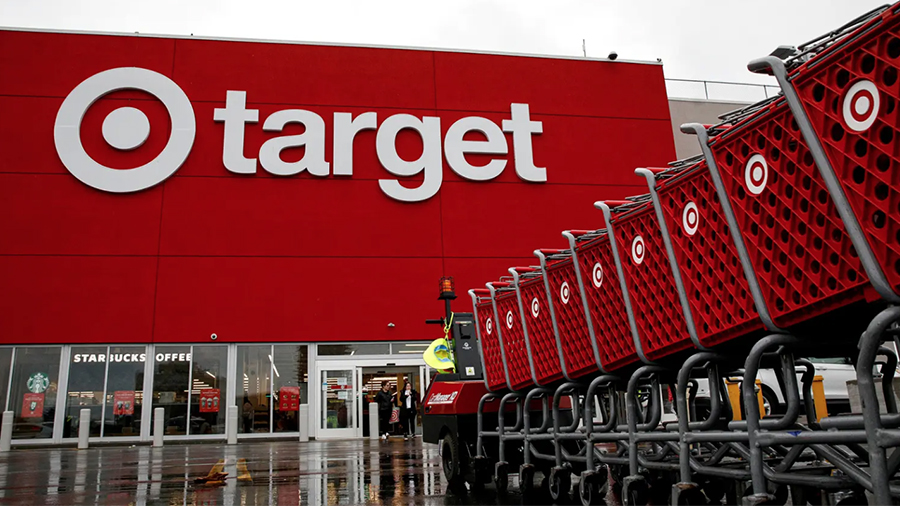Shares of Target fell $23.51, or 13.1 percent, to $155.47 Wednesday after the retailer reported third-quarter profits plunged 52 percent and warned of a sluggish holiday season, blaming inflationary pressures and a deteriorating economic outlook.
Earnings per share in the quarter reached $1.54, down 49.3 percent from $3.04 in 2021. Third-quarter Adjusted EPS of $1.54 decreased by 49.1 percent compared with $3.03 in 2021.
Highlights of the quarter include:
- Comparable sales increased 2.7 percent, compared to 12.7 percent growth last year;
- Comparable sales growth was driven by 1.4 percent traffic growth and a 1.3 percent increase in average tickets;
- Category performance was led by growth in frequency businesses, including Beauty, Food and Beverage and Household Essentials, which offset continued softness in discretionary categories;
- Target saw unit share gains across all five core merchandising categories;
- Third quarter operating margin rate of 3.9 percent improved compared with second quarter results but fell short of expectations;
- In light of an increasingly challenging environment, Target lowered its topline and bottom-line expectations for the fourth quarter; and
- Target announced an enterprise initiative to simplify and gain efficiencies across its business, representing an estimated cumulative savings opportunity of $2 billion to $3 billion over the next three years.
“In the third quarter, our business delivered comparable sales growth of 2.7 percent, and we saw unit share gains across all of our core merchandise categories. This performance demonstrates the durability of our business model, which continues to serve our guests and drive loyalty despite the challenging economic environment,” said Brian Cornell, chairman and CEO, Target Corp. “In the latter weeks of the quarter, sales and profit trends softened meaningfully, with guest shopping behavior increasingly impacted by inflation, rising interest rates and economic uncertainty; this resulted in a third-quarter profit performance well below our expectations.
“While we’re ready to deliver exceptional value for our guests this holiday season, supported by the decisive inventory actions we took earlier this year, the rapidly evolving consumer environment means we’re planning the balance of the year more conservatively. We’re also taking new actions to drive efficiencies now and in the future, optimizing our operations to match the scale of our business and drive continued growth. The strides we have made in recent years to build a truly differentiated, guest-centered retail offering, punctuated by a balanced, multi-category portfolio, positions us well to navigate any environment.
“Looking ahead, we remain laser-focused on delivering the best of Target to our guests and continuing to invest in our long-term, profitable growth.”
Fiscal 2022 Guidance
Based on softening sales and profit trends that emerged late in the third quarter and persisted into November, the company said it believes it is prudent to plan for a wide range of sales outcomes in the fourth quarter, centered around a low-single-digit decline in comparable sales consistent with those recent trends. Similarly, the company is now planning a wide range for its fourth-quarter operating margin rate centered around 3 percent.
“As we look ahead, we expect the challenging environment to linger beyond the holiday season and into 2023,” Chief Financial Officer Michael Fiddelke said on the call with reporters. The quarter’s margin shortfall reflected higher-than-expected markdowns, especially in the final weeks of the quarter, Fiddelke said. Target is also seeing a higher level of shoplifting, which jumped about 50 percent year-over-year and was attributed to organized crime.
Enterprise Efficiency
The company announced it was undertaking an enterprise-wide effort to simplify and gain efficiencies across its business, focusing on reducing complexities and lowering costs while continuing to support its employees. Through this work, the retailer believes it could save $2 billion to $3 billion over the next three years. These savings will support its investments in driving deeper consumer engagement and long-term growth while also delivering on its profit goals. This opportunity is enabled by rapid growth since 2019, in which Target’s total revenue has grown approximately 40 percent. In light of this growth, this effort is focused on leveraging the scale gained to best position the company to continue growing efficiently over time.
Operating Results
Comparable sales in the quarter grew 2.7 percent in the third quarter, reflecting comparable store sales growth of 3.2 percent and comparable digital sales growth of 0.3 percent. Total revenue of $26.5 billion grew 3.4 percent compared with last year, reflecting total sales growth of 3.3 percent and a 9.5 percent increase in other revenue. Operating income was $1.0 billion in third quarter 2022, down 49.2 percent from $2.0 billion in 2021, driven primarily by a decline in the company’s gross margin rate.
Third quarter operating income margin rate was 3.9 percent in 2022, compared with 7.8 percent in 2021. Third quarter gross margin rate was 24.7 percent, compared with 28.0 percent in 2021. This year’s gross margin rate reflected higher markdown rates, inventory shrink and merchandise and freight costs, net of retail price increases, compared with last year. Additionally, gross margin rate was pressured by increased compensation and headcount in our distribution centers and the costs of managing early receipts of inventory, with a slight offset from the favorable category mix. Third quarter SG&A expense rate was 19.7 percent in 2022, compared with 18.9 percent in 2021; this reflected the impact of cost inflation across multiple parts of the business, including investments in hourly team member compensation, which was partially offset by lower incentive compensation.
Photo courtesy Target/Reuters
















